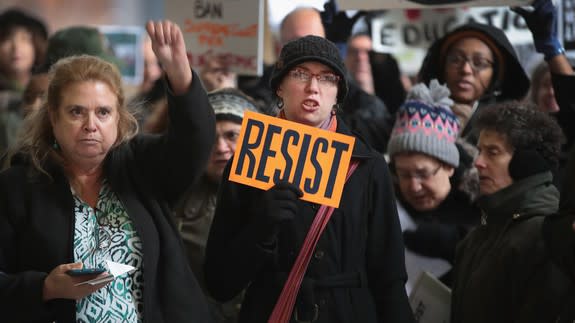These are the most-tweeted emojis from anti-Trump protests

These days, when emotions run high, so does emoji usage.
Hamdan Azhar, founder of data journalism lab Prismoji, recently looked into the most frequently used emojis in tweets related to topics like the Women's March and President Donald Trump's "Muslim ban." He outlined his findings in a blog post for Emojipedia.
SEE ALSO: Twitter accounts form digital army in resistance against Trump
Using Twitter APIs, Azhar analyzed about 60,000 tweets (excluding retweets and duplications) and identified the top five emojis for the following viral hashtags: #NoBanNoWall (grouped together with #NoMuslimBan), #NotMyPresident, #TheResistance and #WomensMarch.


Image: Emojipedia
Some of the most frequently used emoji include the red heart (❤️️ ), face with tears of joy (😂), the American flag (🇺🇸 ) and the raised fist (✊ ). The raised fist emoji was also prominent in #BlackLivesMatter tweets.
So while dumpster fire (🗑 🔥 ) may be the most symbolic emoji combination for 2016, the raised fist might be the one perfect icon for everything that came after.
The graph that charts frequency of emoji usage gives us an insight into the possible moods and feelings associated with a particular movement. For example, #NotMyPresident seems to show a combination of disappointment and anger, while the #WomensMarch appeared to convey mostly determination and hopeful sentiments.
Emojis have come a long way since their inception in Japan in the 1990s, and they're now a crucial element of modern pop culture. While they started as an obsession among mobile phone users, in recent years, their use has become much more political. Introduction of new emojis often have something to do with bringing about greater societal representation—like the redhead emoji and the interracial couple, for example.
Azhar's analysis specifically focused on those tweeting in protest of the new administration, so he noted that the symbolism may signify different meanings to those who support President Trump's recent actions. It's also worth noting that during the election, emojis were also a source of contention for the Trump campaign. Their requests for custom hashtag emojis for the first and second presidential debates were eventually denied by Twitter, and some say the denial cost Twitter CEO Jack Dorsey his invite to Trump's tech summit in December 2016.
With Twitter being a source of political venting for many, it's possible that we'll see more custom hashtag emojis (or Hashflags) created specifically for future protests and marches. But for now, it looks like we'll continue to see many more ✊ in resistance-related tweets to come.

 Yahoo News
Yahoo News 